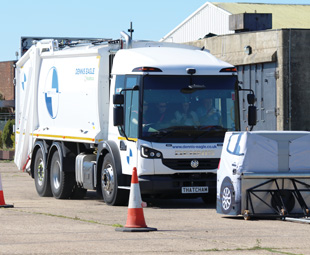Stop on sight!

Since November 2015, new European trucks with a gross vehicle mass (GVM) above eight tonnes have been required to be fitted with an Autonomous Emergency Braking System (AEBS). BRIAN WEATHERLEY, of Fleet Transport, explains what’s involved.
It only takes a frighteningly brief period of inattention for a driver to run a fully laden truck into the back of a stationary queue of traffic or a slow-moving vehicle … with catastrophic results. Fortunately, the latest safety laws from Brussels will play an increasingly major role in reducing such potentially horrific tail-end collisions.
In November 2015, AEBS became mandatory on most newly registered two- and three-axle rigid trucks and tractors with air suspension above a GVM of eight tonnes. The move is part of the ongoing European Safety Directive, which also sees the adoption of Electronic Stability Control (ESC) and Lane Departure Warning (LDW) systems on heavy commercial vehicles. Only four-axle and off-road vehicles are exempt from AEBS, for now.
AEBS is being rolled out in three stages (referred to as “Levels 1, 2 and 3”) requiring progressively improved automatic-braking performance from a truck approaching both stationary and moving “targets”.
 Under ideal conditions, with AEBS operating, a truck should either avoid a tail-end collision altogether, or else have its impact speed reduced to such an extent that the AEBS acts as a “collision mitigation system” – significantly lowering the risk of serious injury to vehicle occupants.
Under ideal conditions, with AEBS operating, a truck should either avoid a tail-end collision altogether, or else have its impact speed reduced to such an extent that the AEBS acts as a “collision mitigation system” – significantly lowering the risk of serious injury to vehicle occupants.
Level 1 AEBS (the minimum standard) applies to new registrations from November 1, 2015, (and new Type-Approvals since November 2013) and must reduce the impact speed of a truck by ten kilometres per hour, when travelling towards a stationary vehicle at 80 km/h.
Level 2 AEBS (mandatory on new Type Approvals from November 1, 2016, and all new registrations from November 2018) must reduce the impact speed of a truck by 20 km/h when travelling towards a stationary vehicle at 80 km/h.
Under AEBS Level 1, the moving vehicle should avoid a collision if a target vehicle is moving at 32 km/h and truck is travelling at 80 km/h; for Level 2, the threshold speeds are ten kilometres per hour and 80km/h respectively (i.e. a speed reduction of 70 km/h).
Standards for AEBS Level 3 have yet to be confirmed.
Meanwhile, the good news for operators, safety organisations and insurers is that a number of truck builders, including Volvo Trucks and Mercedes-Benz, have long offered AEBS as an option on their respective ranges ahead of the 2015 deadline.
These vehicles also have a braking performance well in excess of that required under AEBS Levels 1 and 2.
Volvo’s Collision Warning Emergency Braking (CW-EB) is typical of the AEBS genre and uses a forward-facing camera and radar scanner (the latter developed from its existing adaptive cruise control) to detect and identify an object directly in front of the truck – whether stationary or travelling at a slower speed.
As with other AEBS products on the market, CW-EB provides a pre-warning alert to the driver – in this case a solid red light shone on the bottom of the windscreen in the driver’s line of sight … which advises of an obstacle ahead.
As the object gets closer, and if the driver does nothing, the alert status is raised: the red light flashes and an audible warning sound will be activated. If the driver still doesn’t react to the warnings, CW-EB then automatically activates the truck’s brakes, first with a mild, or “pre-braking”, application and then with full-pressure braking.
All the manufacturers that Fleet Transport has talked to confirmed that, where possible, their AEBS systems will prevent a collision. However, none (quite sensibly) claim they will be 100-percent effective. That’s because road conditions (for example, rain or ice) will obviously affect maximum braking distances in the event of an emergency stop triggered by AEBS.
The important point to remember with AEBS, though, is that it can significantly mitigate the likely outcome of a rear-end collision by greatly lowering the impact speed; thereby helping to reduce serious or fatal injuries to vehicle occupants.
RIDING SHOTGUN WITH AEBS
Fleet Transport recently experienced AEBS from the passenger seat of both a rigid and a fully loaded articulated truck, provided by Dennis and Volvo Trucks respectively, at a safety technology event held by Thatcham Research – the organisation funded by United Kingdom motor insurers.
The “target” was a dummy car travelling at slow speeds on an extended towing rig behind a Range Rover. As the test trucks approached from directly behind at speeds of
80 km/h, the AEBS on both vehicles detected the slower-moving car and provided an early warning of the obstacle ahead.
When the demonstration drivers deliberately ignored the initial alert, a second warning was given, before the AEBS started braking with impressive results. In both cases a rear-end collision was avoided as each truck stopped dead before hitting the dummy car.

Published by
Focus on Transport
focusmagsa




